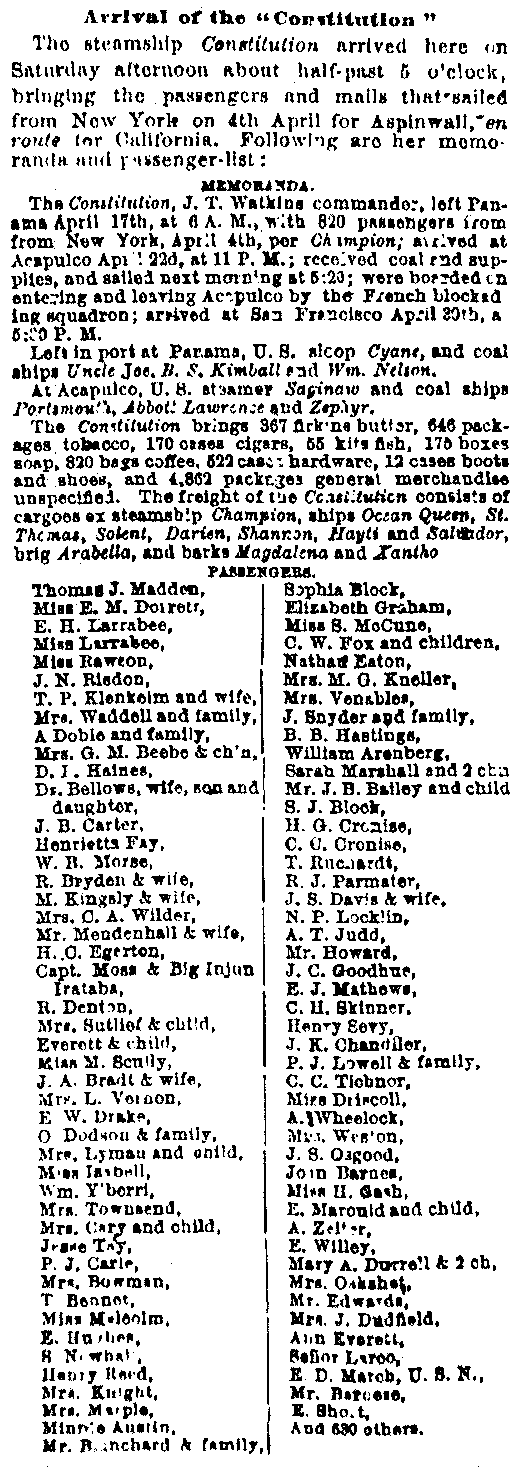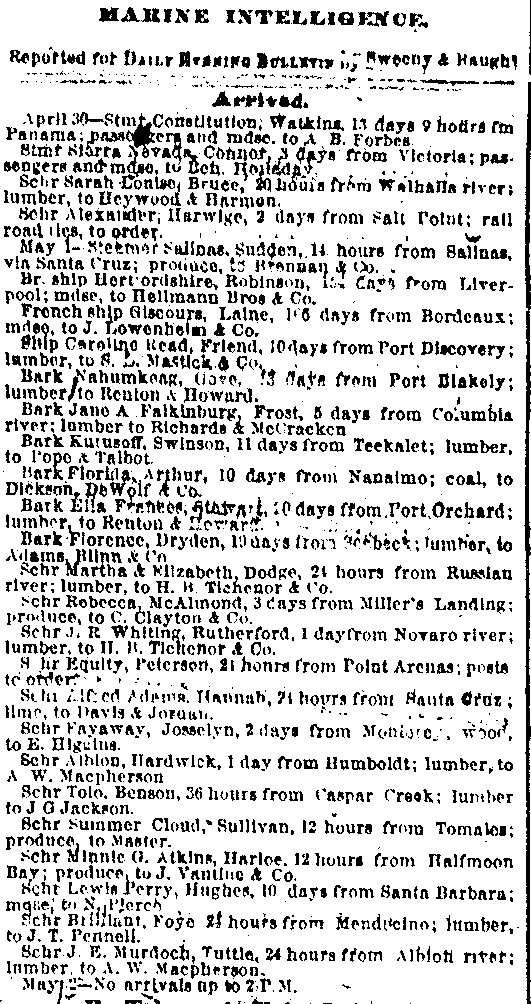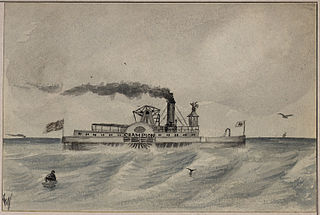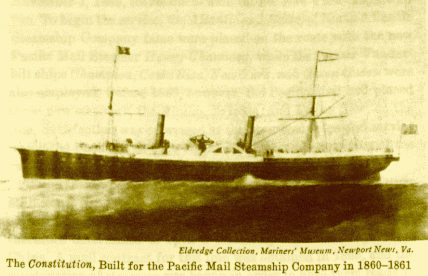

Letters-
By two young Ralston men who traveled from Illinois
to San Francisco via New York and the Panama Isthmus.
Taking 29 days from New York.
To their father
Peter, in Harlem Township, Winnebago Co, Illinois,
USA.
As children, they had immigrated to the USA from
Scotland in 1840 on the British Barque "
Tay".
Verbatum copies.
New York, April 4, 1864
Dear Father. We arrived safe on Friday about 4
o'clock. We were behind time and failed to make
connections, we missed the express at Detroit and we
had to go on the mail train and they stop at every
station. When we got to the office of the steamboat,
he was writing out the last tickets for steerage, we
could not get one. That we would have to wait for the
13. So we thought that if we would have to board 10
days, it would be cheaper, all considered, to buy a
second cabin ticket, so we bought one at $175 each.
There will be a big crowd. The name of the steamer is
the
Champion. She connects with
the
Constitution the other
side of Panama.
We went to hear Dr. McElroy of the Scotch
Presbyterian Church, Sunday. We did not hear him as
he had Dr. Shadd preach for him that day. They have a
presentor and part of them stands up at prayer. We
got along very well through the great city of New
York. We had to pay $2¼ per day. We sail today
at 12:00 noon. No more at present.
We remain your affectionate sons,
C. Ralston,
P. Ralston.

San Francisco, May 3d 1864
Dear Father
We arrived at Aspinwall on the 16th, Saturday, of
April, at 2 o'clock and we stayed till 6
o'clock and then took the cars across the
isthmus. It is a small place and there is quite a
stir when a steamer arrives. It was pretty warm. The
blacks were going around selling cold lemonade for
10cts a glass, and all kinds of fruit. The passengers
were eating and drinking regardless of health. We
started at 6 o'clock. There was three trains. The
road is through a marshy and small brush and little
trees and hills. It is very crooked, curving around
hills very high.. We saw a few huts thatched with
bark or leaves. Some of them with the sides open. It
was at night and you would see them sitting on the
ground with a lamp burning. There was a few places
along the road like that. You would wonder how the
road was built. We arrived at Panama at about 11
o'clock at night. Went aboard a steam tug that
brought us to the steamer anchored out in the bay. We
got aboard about 1 o'clock and started at 6
Sunday morning. We had a very good passage, but head
winds for two or three days. It blowed very hard
ahead. But the Pacific is not like Atlantic, it
don't get so rough. If we had such a blow on the
Atlantic we would have a very rough sea. The steamer
called at Acapulco, a place in Mexico, for coal and
water. She also took aboard several head of cattle.
She carries her own beef on the hoof. The natives
came in their boats selling oranges, bananas, pine
apples, coconuts, shells, etc. We got along without
anything of interest. Sometimes in sight of land. All
high land, very high mountains, all rocky and barren.
There was a case of Panama fever brought on by eating
Panama fruit. There was plenty measles aboard, of
course we thought we were all right, we had had the
measles. On the 27th and 28th it was rough, the ship
rode up and down and passengers were a little
(illegible) not much than me and Peter did not feel
just quite well. On Friday morning when I saw
Peter's face it was all over with spots. Well it
could not be the measles for he had them before. He
was up all the time, and did not feel very sick, for
we had no place lie but on the deck. After breakfast,
(he could not eat any breakfast), he got sick and had
to go below, A man gave him his bunk. So I called the
Dr. and he said it was the measles. He called it the
black measle. The worst measle. He said if a person
did not have the measles right it would be the black
measles. This was on Friday. On Saturday we arrived
at San Francisco and he was in his bed. He had to get
up and go ashore into an omnibus to the hotel. He put
on his overcoat and mine and walked to the bus. We
got to the hotel and got him to bed. He was none the
worse for it. He was not very sick at all. It was not
like the measles in Illinois. He was fevered the
first day but after that he had no fever, did not
drink hardly any, very little of the symptoms that he
had before. He lay Sunday and Monday till 11
o'clock and got up. He felt a little weak but
gained strength very fast.
Monday, May 8.
We have stayed in San Francisco till now so that
Peter would get well. He has got well now. Everything
is dried up in this State, no rain fell for 2 years.
The crops is mostly ruined. Some places they turn in
their stock. Times is dull. We calculated to go to
Nevada Territory but they say that the times is dull
and many idle on account of dry weather. Water is
scarse in some places. We start up the Sacramento
river today. We paid 7 dollars a week for board. This
place is a sandy and dusty city. We are anxious to
hear from home, and to hear how you are and how you
are getting along. And if you are in good health and
all the rest. As soon as we get a place we will write
Thomas. We are thankful to God who has led us this
far through many dangers, may he keep us in his
keeping, and we shall be safe. Let Thomas see this.
No more at present.
I remain your Affectionate son.
C. Ralston.
Daily Evening Bulletin, May 2, 1864, page 5.
Daily Evening Bulletin, May 2, 1864, page 5.
Daily Alta California, May 1, page 6.
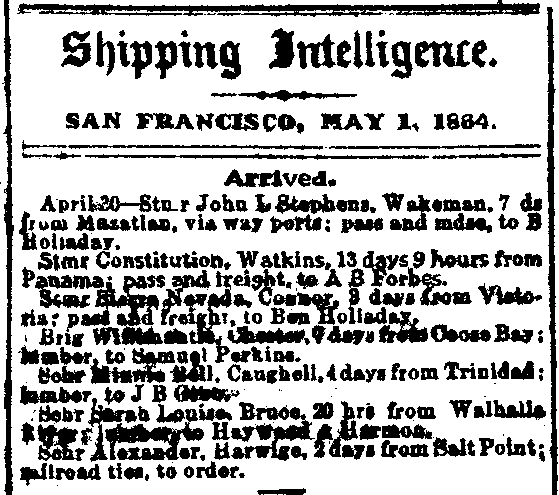

The following information about their trip appears
in "The Argyle Settlement In History and
Story" by Daniel G Harvey, 1924.
"Charles and Peter Ralston, were the sons of
Elder Peter Ralston who owned
the farm on West Lane formerly owned by J. R.
McDonald, emigrated to California in the spring of
1864. On leaving the settlement, they went to New
York and took passage on a boat for Panama to sail
the fourth of May, (the letter home was dated April),
1864. They were ten days in going from New York to
Panama. They crossed the Isthmus by rail, there being
a railway across to the Pacific Ocean at that time.
From there they took ship to San Francisco, arriving
on June 6, (the letter home was dated May), 1864.
They remained during the summer then went to Oregon.
Later they came to Kansas where they bought a farm
four miles from Lawrence. Charles Ralston married,
and the brothers lived together for a number of
years. The later years of Charles' life were
devoted to earnest Christian work. When a child he
was baptised in the Presbyterian Church. In later
years he united with the Baptist Church and was
immersed believing that to be the true rite of
Baptism. He died some years ago. He had one son,
Ernest Ralston who is on his father's farm. Peter
Ralston never married and lived with his nephew until
his death which was in the month of March,
1916."

From: "Classics in Maritime History
Series"," Kemble: The Panama Route,
1848-1869", page 218.
"Iron side-wheel steamer; 3 decks, 2 masts,
round stern, no figurehead; 1,419 15/95 tons; 235 ft.
x 35 ft. x 18 ft. (1859); 1, 452 66/100 tons (186);
draft 12 ft.; double-beam engine built by Harlan and
Hollingsworth; diameter of cylinders 3 ft. 6 in.,
length of stroke 10 ft.; 2 boilers 24 ft. 4 in. x 0
ft., 28 lbs. pressure. First iron ship of any size
built in the United States. Hull plates of wrought
iron 1/2 to 7/8 in. thick. Four water-tight
compartments. Upper deck had two tiers of staterooms
entered only from deck outside. Ninety-six state
rooms in main cabin containing sleeping
accommodations for 388 cabin passengers; room for 350
steerage passengers; total passenger capacity, 900.
Schooner-rigged. Cost $145.000."

"Wooden side-wheel steamer; 3 decks, 2 masts,
round stern, no head; 3,315 3/95 tons; 342 ft. 6 in.
x 44 ft. 8 in. x 22 ft. 4 in. (1861); 3,575 36/100
tons (1856); vertical-beam engine built by the
Novelty Iron Works; diameter of cylinder 8 ft. 9 in.,
length of stroke 12 ft., diameter of paddle wheels 40
ft.; face of paddles 18 ft. Built by William H. Webb,
New York, for the Pacific Mail Steamship Company.
Keel laid December 8, 1860. Launched May 25, 1861.
Chartered by the Quartermaster's Department, War
Department, in 1861 and 1862 at $2,500 per day.
Sailed from New York for San Francisco on June 19,
1862. Served between San Francisco and Panama from
1862 through June, 1869. Broken up at San Francisco
in 1879."
132
